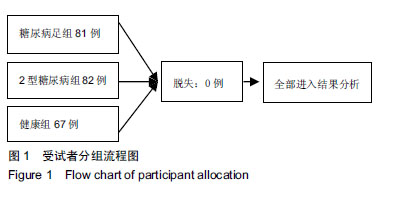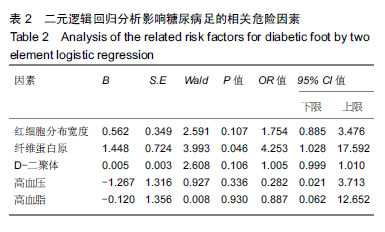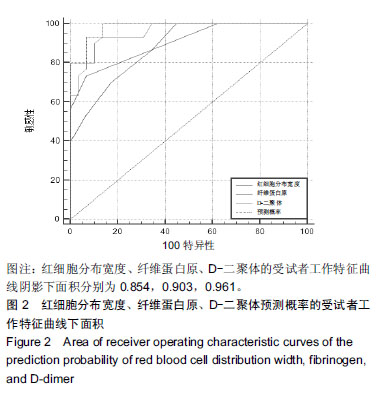| [1]Baglioni P,Malik M,Okosieme OE.Acute Charcot foot. BMJ. 2012;344(344):e1397.[2]Löndahl M. Hyperbaric Oxygen Therapy as Adjunctive Treatment of Diabetic Foot Ulcers. MED CLIN N AM.2013; 97(5):957-980.[3]Lipsky BA, Berendt AR, Cornia PB, et al.Executive Summary: 2012 Infectious Diseases Society of America Clinical Practice Guideline for the Diagnosis and Treatment of Diabetic Foot Infections. 2012. Clin Infect Dis. 2012;54(12):1679-84[4]Demetriou M,Papanas N,Panopoulou M,et al.Determinants of Microbial Load in Infected Diabetic Foot Ulcers: A Pilot Study. Int J Endocrinol. 2013;2013:858206.[5]Tabur AS,Eren MA,Çelik Y,et al.The major predictors of amputation and length of stay in diabetic patients with acute foot ulceration. Wien Klin Wochenschr. 2015;127(1-2): 45-50.[6]Isik T,Uyarel H,Tanboga IH,et al.Relation of red cell distribution width with the presence, severity, and complexity of coronary artery disease.Coron Artery Dis.2012;23(1):51-56.[7]Ak?n F,Köse N,Ayça B,et al.Relation Between Red Cell Distribution Width and Severity of Coronary Artery Disease in Patients With Acute Myocardial Infarction.ANGIOLOGY. 2012; 64(8):592-596.[8]Wonnerth A, Krychtiuk KA, Mayer FJ, et al. Red cell distribution width and mortality in carotid atherosclerosis. Eur J Clin Invest. 2016;46(2):198-204.[9]Veeranna V,Zalawadiya SK, Panaich S, et al. Comparative analysis of red cell distribution width and high sensitivity C-reactive protein for coronary heart disease mortality prediction in multi-ethnic population: Findings from the 1999–2004 NHANES. Int J Cardiol. 2013;168(6): 5156-5161.[10]Wells PS,Owen C,Doucette S,et al.Does this patient have deep vein thrombosis?.Jama. 1998;279(14):1094.[11]Wells PS,Anderson DR,Rodger M,et al.Excluding pulmonary embolism at the bedside without diagnostic imaging: management of patients with suspected pulmonary embolism presenting to the emergency department by using a simple clinical model and d-dimer. Ann Intern Med. 2001;135(2): 98-107.[12]Lowe GD.Fibrinogen and cardiovascular disease: historical introduction. Eur Heart J. 1995;16 Suppl A:2-5.[13]Smith EB.Fibrinogen, Fibrin and the Arterial Wall. Eur Heart J. 1995;16 Suppl A:11-4; discussion 14-15. Review.[14]Zubair M, Malik A, Ahmad J. Incidence, risk factors for amputation among patients with diabetic foot ulcer in a North Indian tertiary care hospital.The Foot.2012;22(1):24-30.[15]Karrer S.Diabetisches Fu?syndrom.Der Hautarzt.2011;62(7): 493-503.[16]Gupta AK,Humke S.The prevalence and management of onychomycosis in diabetic patients. Eur J Dermatol. 2000; 10(5):379-84. Review..[17]Geerlings SE, Hoepelman AI.Immune dysfunction in patients with diabetes mellitus (DM). FEMS Immunol Med Microbiol. 1999;26(3-4):259-265.[18]Cole-King A,Harding KG.Psychological factors and delayed healing in chronic wounds. Psychosom Med. 2001;63(2): 216-220.[19]Harrington AM,Ward PC,Kroft SH.Iron deficiency anemia, beta-thalassemia minor, and anemia of chronic disease: a morphologic reappraisal. Am J Clin Pathol. 2008;129(3): 466-471.[20]Romero AJ,Carbia CD,Ceballo MF,et al.[Red cell distribution width (RDW): its use in the characterization of microcytic and hypochromic anemias].Medicina.1999;59(1):17-22.[21]Symeonidis A,Athanassiou G,Psiroyannis A,et al.Impairment of erythrocyte viscoelasticity is correlated with levels of glycosylated haemoglobin in diabetic patients.Clin Lab Haematol. 2001;23(2):103-109.[22]Livshits L,Srulevich A,Raz I,et al.Effect of Short-Term Hyperglycemia on Protein Kinase C Alpha Activation in Human Erythrocytes. Rev Diabet Stud. 2012;9(2-3):94-103.[23]Patel KV, Mohanty JG, Kanapuru B. Association of the Red Cell Distribution Width with Red Blood Cell Deformability.Adv Exp Med Biol.2013;(765):211-216.[24]Rodrã Guez-Carrio J, Alperi-Lã Pez M, Lã Pez P, et al.Red cell distribution width is associated with endothelial progenitor cell depletion and vascular-related mediators in rheumatoid arthritis. Atherosclerosis.2015;240(1):131-136.[25]Solak Y,Yilmaz MI,Saglam M,et al.Red cell distribution width is independently related to endothelial dysfunction in patients with chronic kidney disease.Am J Med Sci. 2014;347(2): 118-124.[26]Demirkol S,Balta S, Celik T, et al. Assessment of the relationship between red cell distribution width and cardiac syndrome X. Kardiol Pol. 2013;71(5):480-484.[27]Nada AM.Red cell distribution width in type 2 diabetic patients.Diabetes, Metabolic Syndrome and Obesity: Targets and Therapy.2015;(8):525-533.[28]Xiong X,Yang Y,Chen X,et al.Red cell distribution width as a significant indicator of medication and prognosis in type 2 diabetic patients. Sci Rep. 2017;7(1):2709.[29]Li XH,Guan LY, Lin HY, et al. Fibrinogen: A Marker in Predicting Diabetic Foot Ulcer Severity. J Diabetes Res. 2016;2016:2358321.[30]Howard SC, Algra A, Rothwell PM. Effect of age and glycaemic control on the association between fibrinogen and risk of acute coronary events after transient ischaemic attack or stroke. Cerebrovasc Dis. 2008;25(1-2):136-143.[31]Lip GY,Lowe GD.Fibrin D-dimer: a useful clinical marker of thrombogenesis?. Clin Sci (Lond). 1995;89(3):205-214.[32]Yarnell JW,Baker IA,Sweetnam PM,et al.Fibrinogen, viscosity, and white blood cell count are major risk factors for ischemic heart disease. The Caerphilly and Speedwell collaborative heart disease studies. Circulation. 1991;83(3):836-844.[33]Thaulow E,Erikssen J,Sandvik L,et al.Blood platelet count and function are related to total and cardiovascular death in apparently healthy men. Circulation. 1991;84(2):613-617.[34]Papageorgiou N,Tousoulis D,Siasos G,et al.Is fibrinogen a marker of inflammation in coronary artery disease?. Hellenic J Cardiol. 2010;51(1):1-9.[35]Kotbi S,Mjabber A,Chadli A,et al.Correlation between the plasma fibrinogen concentration and coronary heart disease severity in Moroccan patients with type 2 diabetes. Prospective study. Ann Endocrinol (Paris). 2016;77(5): 606-614.[36]Yao HQ,Wang FJ,Kang Z.Effects of endovascular interventions on vWF and Fb levels in type 2 diabetic patients with peripheral artery disease. Ann Vasc Surg. 2016;33: 159-166.[37]Wells PS, Owen C,Doucette S,et al.Does this patient have deep vein thrombosis?.Jama. 1998;279(14):1094.[38]Lippi G,Franchini M,Targher G,et al.Help me, Doctor! My D-dimer is raised. Ann Med. 2008;40(8):594-605.[39]Fu Z, Yao F, Abou-Samra AB,et al.Lipasin, thermoregulated in brown fat, is a novel but atypical member of the angiopoietin- like protein family. Biochem Biophys Res Commun. 2013; 430(3):1126-1131.[40]Hess K.The vulnerable blood. Coagulation and clot structure in diabetes mellitus. Hamostaseologie. 2015;35(1):25-33.[41]Nwose EU,Richards RS,Jelinek HF,et al.D-dimer identifies stages in the progression of diabetes mellitus from family history of diabetes to cardiovascular complications. Pathology. 2007;39(2):252-257. |
.jpg) 文题释义:
红细胞分布宽度(RDW):是反映红细胞体积异质性的参数,用红细胞体积大小的变异系数来表示,比血涂片上红细胞形态大小不均的观察更客观、准确。
D-二聚体(D-Dimer):是纤维蛋白单体经活化因子XIII交联后,再经纤溶酶水解所产生的一种特异性降解产物,是一个特异性的纤溶过程标记物。D-二聚体来源于纤溶酶溶解的交联纤维蛋白凝块。
文题释义:
红细胞分布宽度(RDW):是反映红细胞体积异质性的参数,用红细胞体积大小的变异系数来表示,比血涂片上红细胞形态大小不均的观察更客观、准确。
D-二聚体(D-Dimer):是纤维蛋白单体经活化因子XIII交联后,再经纤溶酶水解所产生的一种特异性降解产物,是一个特异性的纤溶过程标记物。D-二聚体来源于纤溶酶溶解的交联纤维蛋白凝块。.jpg) 文题释义:
红细胞分布宽度(RDW):是反映红细胞体积异质性的参数,用红细胞体积大小的变异系数来表示,比血涂片上红细胞形态大小不均的观察更客观、准确。
D-二聚体(D-Dimer):是纤维蛋白单体经活化因子XIII交联后,再经纤溶酶水解所产生的一种特异性降解产物,是一个特异性的纤溶过程标记物。D-二聚体来源于纤溶酶溶解的交联纤维蛋白凝块。
文题释义:
红细胞分布宽度(RDW):是反映红细胞体积异质性的参数,用红细胞体积大小的变异系数来表示,比血涂片上红细胞形态大小不均的观察更客观、准确。
D-二聚体(D-Dimer):是纤维蛋白单体经活化因子XIII交联后,再经纤溶酶水解所产生的一种特异性降解产物,是一个特异性的纤溶过程标记物。D-二聚体来源于纤溶酶溶解的交联纤维蛋白凝块。



.jpg) 文题释义:
红细胞分布宽度(RDW):是反映红细胞体积异质性的参数,用红细胞体积大小的变异系数来表示,比血涂片上红细胞形态大小不均的观察更客观、准确。
D-二聚体(D-Dimer):是纤维蛋白单体经活化因子XIII交联后,再经纤溶酶水解所产生的一种特异性降解产物,是一个特异性的纤溶过程标记物。D-二聚体来源于纤溶酶溶解的交联纤维蛋白凝块。
文题释义:
红细胞分布宽度(RDW):是反映红细胞体积异质性的参数,用红细胞体积大小的变异系数来表示,比血涂片上红细胞形态大小不均的观察更客观、准确。
D-二聚体(D-Dimer):是纤维蛋白单体经活化因子XIII交联后,再经纤溶酶水解所产生的一种特异性降解产物,是一个特异性的纤溶过程标记物。D-二聚体来源于纤溶酶溶解的交联纤维蛋白凝块。